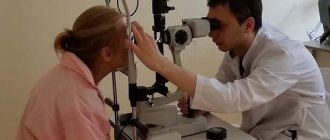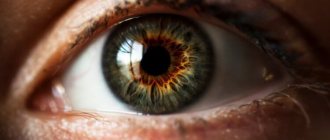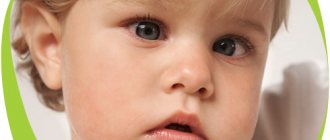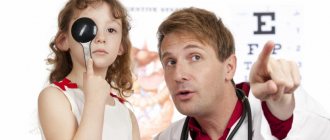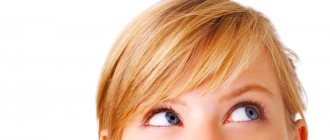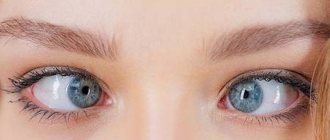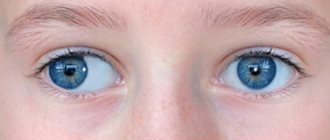Children's strabismus can develop for various reasons. As a rule, the defect manifests itself at an early age due to heavy loads on undeveloped vision, injuries, congenital pathologies, and severe fright. Parents should monitor the health of their baby's eyes. The sooner the pathology is identified, the easier it will be to cure it.
Strabismus in children
How to determine strabismus in a child?
Source: glavvrach.com Another common visual disorder in children is strabismus. However, strabismus itself is extremely rarely an independent disorder. Most often, strabismus is a concomitant phenomenon of diseases such as astigmatism and farsightedness.
And in especially severe cases, divergent strabismus in children is a consequence of myopia. Parents should remember that children's strabismus is not just some kind of cosmetic defect, but a severe disruption of the functioning of the entire visual apparatus.
Normally, the human visual system has a structure in which two different images from the two eyes enter through the visual channels into certain areas of the brain, where they are reunited into a single whole.
And only with the correct, well-coordinated work of the entire visual apparatus, the picture acquires the correct clear outlines, thanks to which a person sees objects from the correct angle, and it is also possible to adequately navigate in space.
A baby who has just come into our world is still, in principle, unable to look and see clear objects. The ability to see with both eyes (binocular vision) develops gradually in a child, finally becoming fully formed only by the age of 4–5 years.
I would like to remind you that at this age all children are also susceptible to physiological myopia, which is directly related to the development of strabismus. Therefore, treatment must be exclusively comprehensive - only in this case is it possible to achieve positive dynamics.
Most often, strabismus is diagnosed in children aged three to five years, however, strabismus in infants is quite common. As a rule, the first to notice symptoms of trouble are parents of children, who spend all their free time with their children.
Many parents ask how to determine strabismus in a child. In fact, if a child does develop strabismus, you will immediately notice it with the naked eye, even without special education.
And if you notice that your child is squinting even a little, rush to seek help from a pediatrician - an ophthalmologist for advice as soon as possible.
You should not be afraid that you will bother the doctor in vain - when it comes to the child’s health, it is much better to be safe than to miss the onset of any disease. Not a single doctor will refuse to help you or blame you.
After all, only an ophthalmologist knows how to treat strabismus in children. Correcting strabismus in children is a labor-intensive process and requires a lot of effort, both from the doctor and from the parents.
Prevention
It is easier to prevent a disease than to treat it later. In this case, you can give the following advice to parents:
- combat ophthalmological diseases in a timely manner;
- Carry out frequent examinations with a doctor;
- Follow the rules for eye strain.
If you notice that your child's vision has become worse, you should not buy glasses yourself. If you choose the wrong optics, your vision can only get worse. The sooner you deal with your child’s strabismus, the better. It is necessary to get rid of the disease before school time in order to avoid psychological trauma. Monitor your child’s posture and do not allow him or her to sit at the computer for a long time.
In our material, we talked about the causes and treatment of strabismus in children, and also discussed the symptoms and classification. This information will be useful to young parents, because the disease can affect every baby. If the disease is treated at an early age, it will not affect the quality of vision in the future. In this situation, the principle works: the sooner, the better. The specific method of therapy will be selected by the attending physician after a series of studies.
Classification
Ophthalmologists offer several classification options for this type of disease. The most common is the division into three main subtypes: imaginary strabismus, esotropia and exotropia.
- Imaginary strabismus
- Esotropia
It is observed in children under one year of age. It is characterized by the anatomical feature of the eyelids, the presence of skin folds in the peripheral zone of the cornea of the eye with a relatively wide bridge of the nose. The fold covers some area of the eye, and a visual effect is created from the side as if the baby’s eyes are looking in different directions.
With age, the child “outgrows” this anatomical defect and not a trace remains of strobism. That is, if a specialist determines that a child has imaginary strabismus, then parents should have no reason to worry, this is not a disease.
The pupil deviates towards the nose. There are two subtypes of esotropia: congenital and accommodative.
- Congenital esotropia is a pronounced heterotopia caused by genetic predisposition. Identified in babies aged 0 to 6 months. A peculiarity of this type is that during periods of deterioration in health or during times of fatigue, the child experiences an increase in the effect of a squinted gaze.
- Accommodative esotropia, detected in children aged eight months to four years, is usually a concomitant disease - childhood ametropia (farsightedness). A child, when examining an object at close range, strains the muscles of the eye, and a deviation occurs. It is at these moments that strabismus most clearly manifests itself. That is, there is a direct relationship: the more often the child examines small objects at close range, the better the disease is expressed. The dynamics of this type of strabismus are varied, from rapid deterioration to a relatively low rate of development.
- Exotropia
The eye deviates towards the temple. As a rule, this type of strabismus begins to appear in children aged one year. It may be temporary or permanent. Unlike the previous case, it occurs when the patient peers into the distance for a long time, but when examining objects close up, it is either barely noticeable or disappears altogether. In this case, the child may experience headaches, the object of observation may split in two, and tearing appears.
Is strabismus always noticeable with the naked eye?
Strabismus can be vertical, divergent and convergent, most often with one or both eyes clearly squinting. However, there is also a hidden form of childhood strabismus, which is not outwardly noticeable. It occurs due to muscle imbalance and is dangerous because it causes rapid eye fatigue.
This, in turn, leads to myopia. The disorder develops in the first months of life, and can manifest itself more clearly in the third year of life, when the child is interested in activities that require visual strain - modeling, drawing.
Sometimes strabismus is observed in newborns. This is due to weakness of the eye muscles and is normal. The reason for contacting an ophthalmologist is the presence of obvious strabismus in a child older than six months.
What should you pay attention to first?
Recently, more and more often, ophthalmologists have to diagnose various visual impairments. Very often, doctors diagnose strabismus in children under one year of age.
This is influenced by a huge number of different factors, including the environmental situation, computers and televisions, which have become firmly established in the life of a modern person, complications during the mother’s pregnancy, and many others.
The factor of genetic predisposition is also important - vision problems often tend to be passed on from generation to generation, from children to parents.
If the baby’s parents have any vision problems, be it myopia, farsightedness, astigmatism or strabismus, there is a fairly serious risk that their child will also have a tendency to the same diseases.
That is why parents with vision problems should treat their baby’s vision as carefully as possible. After the baby reaches three months of age, parents should definitely go to an ophthalmologist to get the first consultation in the baby’s life.
Most often, a referral to an ophthalmologist is given by the pediatrician who is observing the baby. However, if for some reason your pediatrician did not give you a referral to an ophthalmologist, do not hesitate to remind him about it yourself.
An ophthalmologist will carefully examine your baby and conduct the necessary examination, which will help the doctor identify possible visual impairments. If the baby has any problems, the doctor will tell the parents what needs to be done next.
And if the child needs treatment, it is the ophthalmologist who will write out the treatment regimen or refer him for hospitalization to a specialized hospital. If no one in your family has had any problems with vision, the baby’s first visit to the ophthalmologist should be at six months.
After this, if the ophthalmologist does not detect any violations, the next visits will take place as planned, during preventive examinations of the child. In no case, if the doctor says that the child’s vision is fine, do not ignore subsequent visits.
As you know, not all vision problems are congenital - many eye diseases are acquired over time, under the influence of a huge number of adverse effects on the baby’s eyes.
You should also draw the attention of parents to the fact that in no case should you completely rely only on doctors. Firstly, you won't visit an ophthalmologist every week, will you?
And secondly, individual symptoms of some diseases can only be noticed by parents who spend almost all the time with their child. Therefore, mothers and fathers must be extremely attentive and watch the baby.
Ophthalmologists, as a rule, tell parents about which aspects of children's vision need to be paid special attention to. Below we have described the main ones - read carefully and try to remember this information. So:
The baby's reaction is not bright
Almost all young mothers have more than once observed the following picture: the light turns on in the child’s room, and the child immediately reacts to this - he turns his head away, closes his eyes and shows other signs of dissatisfaction. This reaction is the physiological norm.
By closing his eyes, the child thus instinctively protects his eyes, helping them adapt to bright light. But if the baby does not react in any way to bright lighting, especially to a light suddenly turned on in a dark room, parents need to be wary.
In this case, there are two acceptable explanations: either you are lucky and you are the parents of an unrealistically calm child, or, what is more likely, your baby has certain vision problems.
To find out if this is so, try to casually direct a beam of light directly into the baby’s eyes and hold it for 1 - 2 seconds. Never let sunbeams into your baby's eyes - this can damage the retina.
If in this case the baby does not react in any way to the bright light, parents should seek help from an ophthalmologist as soon as possible and show the child to him. The doctor will examine the child and accurately diagnose or, on the contrary, dispel your fears and concerns.
Recognizing your toys
Pay attention to whether your baby can independently find his toys - rattles, balls, dolls. If the child’s vision is fine, he will recognize his toys even from a distance. Moreover, the child should see them equally well with both eyes - both right and left.
If your child is old enough, you can try to test your vision yourself - show him an object and ask him to name it. After that, move on to smaller details - for example, ask to tell what color the wheel of the car is or find out if there is a pocket on the doll's skirt.
But even if the baby is not yet big enough and cannot yet maintain a dialogue, attentive parents are able to notice that not everything is in order with the baby’s vision.
For example, some parents whose children suffer from eye diseases say that a situation very often occurs when the child persistently reaches out to an object that interests him. But as soon as you give him the object, the baby throws it and may even cry.
This happens because the baby is disappointed, since the item turned out to be not at all what the baby wanted to receive. If this periodically happens to your baby, be sure to consult an ophthalmologist.
Squinting your eyes
Have you noticed that sometimes, when looking at some objects that are at a great distance from the child, your baby begins to squint his eyes?
Try asking him a few leading questions that will allow you to understand whether the child sees these objects. If the child cannot answer these questions, or complains that he sees poorly, take this into account and show the child to an ophthalmologist as soon as possible.
Assessing the location of various objects
A very important factor in good vision is the child’s ability to follow a moving object with his eyes without losing it from his field of vision. Even very small babies discover this skill by following their mother, a rattle or a mobile phone with their eyes. If your baby fails to do this, show him to the doctors.
Moreover, please note that you need to consult not only an ophthalmologist, but also a neurologist, since the child’s inability to follow objects with his eyes may also indicate the presence of disturbances in the normal functioning of the central nervous system.
Red eyes, watery eyes
If the child's eyes periodically look inflamed and red, pay attention to whether the child's eyes are overloaded - perhaps he spends too much time in front of the TV or at the computer? Or maybe he cried recently?
If the eyes turn red periodically, and for no apparent reason, this is also an alarm signal for parents - be sure to consult an ophthalmologist, who will help determine the cause of regular eye inflammation.
Causes of the disease
- Microphthalmos (shrinkage of the eyeball);
- corneal opacities;
- cataract (clouding of the lens);
- iris coloboma (congenital absence of part of the eye shell);
- uveitis (disease of the uvea);
- above average astigmatism (impaired shape of the lens or cornea), myopia and farsightedness;
- dysarthria or paresis (partial disconnection of muscles from the nervous system);
- paralysis;
- traumatic brain injury;
- infectious disease (influenza, diphtheria, scarlet fever, measles, etc.);
- abnormal development of the eye muscles and other eye diseases;
- stress;
- severe fear;
- somatic diseases (asthenia, neuroses, affective disorders, etc.).
Can strabismus be inherited?
If one of the parents or one of the child’s immediate relatives suffers from strabismus (heterotropia), then there is a possibility that the child will develop this disease. That is why children prone to developing strabismus need to be regularly observed by a pediatric ophthalmologist for timely detection of pathology.
This is because some vision defects, such as abnormalities of the eye muscles or improper attachment of the eye muscles, can be inherited.
What are the causes of strabismus in children?
The causes of strabismus in children can be different - genetic, a consequence of birth trauma or even mental disorders. We will look at the main ones. In addition to genetic factors, the most common cause of strabismus in a child is pathology of pregnancy and childbirth.
Due to fetal hypoxia, as well as due to birth trauma to the cervical spine or brain, innervation is disrupted and the extraocular muscles are deviated from the visual axis. At the same time, myopia, farsightedness and astigmatism can provoke the development of strabismus in a child.
Head injuries, eye surgeries, mental disorders and brain diseases can also cause strabismus in children. There are cases when this pathology occurs in a child after he has had the flu, measles, diphtheria or scarlet fever.
Apparent strabismus
Often, when parents go to the doctor, they complain about their child’s strabismus, but after examination the doctor does not detect it. This happens, as a rule, due to the congenital epicanthus, the structure of the skull or the wide bridge of the nose.
Apparent strabismus is more likely to disappear with age as soon as the skeleton begins to change. To determine hidden strabismus, you can try a cover test.
In this case, when the child has both eyes open, strabismus is not observed, but as soon as one of them is closed, the other begins to move to the side, and when opened, returns to its place. The main condition for this method is this: the child must look at the object that is being shown to him.
At 3 years of age, in addition to the above methods, visual acuity is tested using a table with or without glass correction. The state of binocular vision can be determined using a color test.
Color test technique
The study is carried out using a special disk with luminous circles of different colors located on it (1 red, 1 white and 2 green). The child wears glasses specially designed for this purpose with red glass on the right and green on the left.
Thus, the eyes see the color that is in front of them, that is, the right one is red and the left one is green. The white ball appears as one of two colors due to the filters placed in front of the eyes.
If the baby does not have any visual impairments, he will see 4 circles (either 2 red and 2 green, or red and 3 green). If one eye of a child turns off, he sees 3 green or 2 red circles (monocular vision). If the baby has alternating strabismus, he will see either 3 green or 2 red.
Types of strabismus
There are different types of strabismus. Thus, strabismus can be congenital or acquired. In the first case, the deviation is noticeable immediately after the birth of the baby. Its causes are hereditary factors or abnormal development of the fetus during pregnancy. In the course of life, ophthalmological diseases, heavy load on the organs of vision, head injuries and other reasons lead to strabismus.
The disease can manifest itself externally in different ways. Based on the trajectory of the displacement of the visual axis, strabismus is divided into:
- horizontal;
- vertical.
Horizontal strabismus is divided into:
- convergent strabismus (esotropia), in which the eyeballs converge towards the bridge of the nose. It is considered the most common among other forms of strabismus in children.
- divergent (exotropia), when the eyes squint towards the temple.
Vertical strabismus has the following subtypes:
- hypertropia - one or both eyes are shifted upward;
- hypotropia - one or both eyes are directed downwards.
- mixed, a form of strabismus in which the eye can move up to the temple, or down to the bridge of the nose and vice versa.
The deviation can occur in one or both eyes alternately, either on the right or on the left eye. When only one eye squints, such strabismus is called monolateral. With alternating strabismus, the right and left eyes alternately squint.
According to the manifestation of symptoms, strabismus is:
- hidden (heterophoria). Occurs as a result of disruption of the eye muscles. When one eye closes, the other begins to squint. The rest of the time there is no deviation. It occurs rarely and in most cases does not affect vision.
- compensated. This type of pathology can only be detected by a doctor during a special examination.
- subcompensated. Associated with weakening of the muscles of the organs of vision. The cause may be nervous disorders or illnesses.
- decompensated. Appears for no reason. Typically, a concomitant symptom is severe visual fatigue.
Strabismus is also divided into friendly and paralytic. In the first option, the mobility of the eyeball is preserved. It functions as follows: the healthy eye has the same angle of deviation as the sick eye, but in the opposite direction. In this case, binocular vision is not impaired, and the picture does not double.
Paralytic strabismus is characterized by paralysis of one or more extraocular muscles. The eye deviates in the direction of the damaged muscle.
Sometimes strabismus can develop as a result of inflammation or damage to the nerves that innervate (supply) the extraocular muscles. This type of strabismus is called neurological. Quite often, different types of strabismus are combined in a child. So, for example, it occurs:
- intermittent divergent strabismus;
- if the pathology is complicated by myopia, then divergent concomitant strabismus may occur;
- with farsightedness, concomitant strabismus can be convergent.
How to determine strabismus in a child at home?
Source: zdorovyeglaza.ru
The most effective way to determine all visual impairments is an ophthalmological examination, but strabismus can be detected at home. To do this you will need a flashlight and a camera with flash.
Home diagnostic method
Of course, congenital strabismus is diagnosed already in the first days of our birth. But with acquired things the situation is different: small deviations are not always noticeable immediately, and medical examinations are not so frequent.
And I would like to determine the tendency to strabismus before visible symptoms appear: deviations of one or both eyes towards the nose or to the side, as well as “floating eyes” syndrome (when it is difficult to “catch” the patient’s gaze).
You can take a test for signs of hidden strabismus (or ask your child to do it) now, it only takes a few minutes.
Rules for performing the test
Lean back in a chair so that your head does not move and look out the window at some small immovable object (for example, a store sign or a satellite dish) and try to focus your gaze on this object for two seconds.
Then close your palm, first one, then the other eye, looking at the object for 1-2 minutes. If the object of fixation remains in place and does not jump from side to side when you open each eye, you can be calm.
Well, or almost calm... After all, only modern diagnostic equipment and professional examination can give a 100% result.
What is vertical strabismus?
Strabismus is an ophthalmological disorder in which one or both eyeballs deviate away from the straight direction. When you deviate from the fixation point, the image is distorted. The image the brain receives is double. The patient develops dizziness and headaches. And these are not all the consequences of strabismus. It can cause other eye diseases, including amblyopia, which reduces visual acuity in one eye. This could end badly. If strabismus is not treated, a person's vision will remain monocular.
Strabismus is also a cosmetic defect that is clearly visible to others. Almost any form of this pathology, except for imaginary, hidden or intermittent strabismus, can be identified during an external examination. One or both of the patient's eyes squint to the side. In this case, it can deviate towards the nose or temple. In such cases, convergent or divergent strabismus is diagnosed, respectively. These two types refer to horizontal deflection. If the eyeball squints downwards or upwards, we are talking about vertical strabismus. It does not occur as often as horizontal, but usually it has to be treated surgically.
Let's consider the causes of strabismus of this type.
Self-check procedure
In order to independently test for heterotropy at home, it is enough to sit comfortably in a chair, resting your head on the back so that it does not roll when relaxing.
Having sat comfortably, you need to focus your gaze on a static, distant object with high contrast. This could be a bright sign, inscription, etc.
Focusing on the selected object, you need to cover each eye in turn with your palm for a couple of seconds. Breaks should be no longer than 3 seconds of gaze by both organs of visual perception. You cannot let your hand touch your face.
In such conditions, if performed correctly, the object will be seen as if through a phantom palm. In healthy people, a similar phenomenon occurs due to binocular vision, which is impossible with strabismus.
Features of an unhealthy reaction to the test
People with heterotropia have a special reaction to this test, which has the following manifestations:
- If, during such a kind of verification test, the object is not in one position, but there is a deceptive feeling that it is moving or slightly deviating when moving the palm, this is evidence of the presence of hidden horizontal strabismus.
- When the left eye is closed, you will likely notice a shift of the image to the right, and when the right eye is closed and the left one is open, the effect will be the opposite. This means that you have hidden convergent strabismus.
- If, when the left organ of vision is open, the picture shifts to the right, and the right one to the left, then this is a hidden divergent strabismus.
- If a static object on which the gaze is focused during the test shifts in different directions, then this indicates the presence of a vertical deviation.
How to determine strabismus in a newborn and one-year-old child?
By the end of the first week of a baby’s life, you can independently diagnose the pathology in question. To do this, you need to take a rattle and remove it from the child’s eyes at different distances, moving it from side to side.
Carefully monitor the reaction of the child's eyes when observing a moving object and draw a conclusion about how mobile the baby's pupils are. In newborns, the gaze may be discoordinated until 3-4 months; after this age, both eyes become aligned.
In some cases, in children with a wide bridge of the nose, strabismus may be apparent. You should consult a doctor and sound the alarm only if, after 4 months of life, the child’s eyes do not look at the same point most of the time.
Strabismus in one-year-old children can be recognized by the following signs:
- the child cannot direct his eyes simultaneously to one point in space;
- eyes do not move together;
- one eye squints or closes in bright sun;
- the child tilts or turns his head to look at the object;
- the baby bumps into objects (squint impairs the perception of depth in space).
Let us recall once again that true strabismus is characterized by the deviation of only one eye from the joint point of fixation. At the same time, for a newborn child, a slight defocus of the eyes is considered a completely normal phenomenon, which is observed in all babies.
Moreover, the absence of slight strabismus in a small child is rather an exception to the rule. Firstly, the eye muscles of children are very weak, so they need training. Secondly, the child has not yet learned to use these muscles, so sometimes it is not possible to look in different directions.
That is why small eyes, not listening to their owner, either converge to the bridge of the nose, or scatter in different directions. As soon as the baby learns to control the movements of his eyeballs, the squint will go away.
This pathology in infants is inextricably linked with weakness of the eye muscle. The most common causes of strabismus in newborns are:
- injuries and infectious diseases of the brain;
- changes in the eye muscles of an inflammatory, vascular and tumor nature;
- untimely treatment of myopia, astigmatism, farsightedness;
- congenital diseases and birth injuries;
- increased physical and mental stress;
- placing children's toys too close to the baby's face.
Heredity also quite often causes the development of strabismus in newborns. If one of the parents has this pathology, then there is a high probability that their child will inherit the disease.
Sometimes strabismus manifests itself as a symptom of other congenital diseases or as a result of illnesses suffered by the baby’s mother during pregnancy.
Reasons for development
Esotropia is a congenital defect of the visual organs. It is caused by dysfunction of the part of the brain responsible for the coordinated movement of the eyeballs. In itself, strabismus of this form does not affect the quality of vision. But if the eye is strongly displaced towards the bridge of the nose, amblyopia may develop. With amblyopia, only one eye is fully functional, and it is the defective one. And a healthy person gradually loses his functions. This is explained by the fact that the brain will perceive only the information that comes through the unhealthy eye, while the healthy one will be inactive and, accordingly, will not develop.
Esotropia is usually diagnosed in the following cases:
- in babies born prematurely;
- in children with developmental delays;
- with hydrocephalus;
- with a genetic predisposition to such deviations.
If at least one of the listed factors is present, the child from birth should be shown to an ophthalmologist at least twice a year in order to identify the pathology in time and take action.
Babies born prematurely or with congenital pathologies are at risk.
Medical definition of strabismus
An ophthalmologist determines the presence of strabismus based on the following examinations:
- An examination by an ophthalmologist will help you most accurately determine visual impairment.
- Checking visual acuity.
- Determination of range of motion, squint angle, eye position.
- Examination of the conducting media of the eyes, the anterior segment.
- Refraction of the eyes in a child with narrow and wide pupils.
- Study of binocular vision.
Strabismus can be completely cured in 2-3 years. In this case, it is good to combine medical recommendations with special gymnastics for the eyes. Do not delay your visit to the doctor, since children suffering from strabismus often develop disorders of the nervous system and psychological problems.
How to treat true strabismus?
If the Hirschberg test reveals an asymmetry in the corneal light reflex, the doctor finds oculomotor disturbances or a binocular vision disorder in the child, this may indicate true strabismus. The sooner you start treating it, the more effective the result will be. Typically, in the treatment of childhood strabismus, spectacle correction, gluing of the healthy eye, and techniques that develop visual acuity and binocularity are used. In some cases, surgical treatment is justified.
Thus, tests for the light reflex of the cornea and assessment of oculomotor disorders help to distinguish true from false strabismus. An ophthalmologist should conduct such testing and make a diagnosis. If the examination results show the presence of true strabismus, the doctor will prescribe adequate treatment taking into account the child’s individual characteristics.
MagazinLinz.ru team
Ways to get rid of the disease
Medication alone cannot cure strabismus, however, they can speed up the healing process. These include drops to improve vision, drugs that relax the muscles of the eye and prevent pupillary constriction.
And the main methods of treating strabismus include non-hardware procedures (sets of exercises, glasses and lenses), hardware treatment and surgery. Acquired strabismus in adults is more difficult to correct, since their vision has already been fully developed.
In such cases, often with the help of optical methods, a new model of stereoscopic vision is formed (that is, with the help of lenses a person sees better, but the problem is not solved).
Surgical intervention is necessary in cases where a person is not content with a partial improvement in appearance: after all, the surgeon will not restore binocular vision, but he can “put the eyes back in place” by removing or weakening the eye muscles.
And only modern hardware procedures can “teach” the eyes to see correctly. Here are some popular hardware techniques that your doctor may suggest to eliminate strabismus.
Vertical strabismus: causes
Actually, such deviation of the eye from the point of fixation can be considered a form of manifestation of various types of strabismus. Therefore, the causes of vertical strabismus do not differ from the factors that provoke other types of this disease. There are two main types of it - congenital and acquired. The first can result from:
- diseases of infectious etiology suffered by a woman during pregnancy;
- maternal alcohol abuse during pregnancy, as well as drug addiction and smoking;
- prematurity;
- defects of the eyeballs arising for unknown reasons;
- cerebral palsy;
- genetic predisposition.
Today it has been established that strabismus also has a genetic nature. The mechanism of its transmission has been identified, but no methods have been developed that can influence it, that is, prevent the spread of the defective gene. All these factors can cause strabismus only in children. Strabismus in adults, that is, acquired, develops for other reasons. These include:
- paralysis and paresis;
- eyeball injuries;
- mental disorders;
- refractive errors that cannot be corrected by glasses or lenses;
- pathologies of the nervous system.
These reasons can cause strabismus at any age, including adults. There is also a group of factors that can be responsible for acquired strabismus exclusively in children:
- birth injury;
- infectious diseases suffered in early childhood;
- damage to the parts of the brain that ensure coordinated functioning of both eyes;
- fear and constant stress;
- improper child care.
The reasons listed are general. They can lead to the development of any type of pathology in question, including vertical strabismus. Let's look at the different types of this disease.
Treatment
Source: glavvrach.com
Treatment of strabismus in children should be comprehensive and started in a timely manner. Firstly, it is very important to begin treatment of the underlying disease - myopia, farsightedness or astigmatism.
It is very important to choose the right glasses for a child - this should also be done by an ophthalmologist, but not by employees of optical salons. Often, properly selected glasses can significantly reduce the degree of strabismus, reducing it to almost zero.
However, such treatment is very often not enough. In this case, ophthalmologists provide complex hardware treatment to the children. The treatment program for each child is selected exclusively individually, taking into account the visual characteristics of each child.
In some cases, if the doctor considers it necessary and sees strong indications for this, he will place the child in the ophthalmology department of the hospital for subsequent surgical intervention.
The purpose of this operation is to correct the eye muscles, as a result of which an almost complete cure of strabismus is achieved. With this treatment, doctors achieve almost complete rehabilitation of the child’s visual function.
After doctors restore normal movement of the eyeball through surgery, the child will receive complex conservative treatment for a certain time.
Also, using certain training methods, doctors fully restore the baby’s ability to stereoscopic vision. And once again I would like to remind you that strabismus in children has a variety of causes - therefore it is very important to establish the true one.
Below we have outlined the most common of them, but remember that you should never try to make diagnoses yourself - this can lead to the most unpredictable consequences.
Diagnostics
If you have a problem with strabismus in children, you need to make an appointment with an ophthalmologist. This is the doctor who deals with everything related to the eyes. To confirm or refute the diagnosis, the following methods are used:
- Visual inspection.
- Determination of visual acuity using well-known methods.
- Perimetry, thanks to this study, the field of view can be determined.
- Tests range of eye movement. Refers to a detailed type of visual examination, the specialist observes the reaction of the eyes to the movement of an object up and down and left and right.
- The four-point color test is used to determine the number of eyes a baby can see with.
If the above methods are not enough to make a diagnosis, the doctor sends the baby for a computed tomography and ultrasound examination. Often, the ophthalmologist makes an appointment with his colleagues: a neurologist and an endocrinologist. This is due to the fact that first of all it is necessary to determine the cause of the disease, and then engage in therapy.
Hardware treatment method
The monobinoscope device is used in the treatment of amblyopia and double vision. In such cases, the retina of the eye is exposed to light rays. The choice of this method depends on the age of the patient and the stage of development of strabismus.
A set of computer programs for restoring binocular vision (both eyes see the same picture) allows you to correct strabismus defects in 70% of cases. Infrared laser therapy.
This method of laser vision correction can help the eyes focus correctly; infrared radiation restores the muscles of the eye, improves tissue nutrition and eliminates spasms.
Benefits of magnetic therapy
Magnetotherapy (ATOS). This device affects the eyes using a magnetic field. It is usually used for inflammation of the eyes, but in combination with a special attachment, magnetic therapy is effective for treating the problem of the “lazy eye” - amblyopia.
The Forbis device is used for diagnosis and treatment using the diploptic method (a procedure for consolidating restored binocular vision). Synoptophore “Sinf-1” is suitable for complex treatment of strabismus and helps restore a single image, training general eye mobility.
Physiotherapy
To prevent strabismus, you need to regularly train the eye muscles, and physical activity will also help correct vision in the earliest stages of this disease.
- Exercise 1. All you need to do is extend your arm in front of you and focus on your index finger, closing one eye. Then slowly move your finger ten centimeters closer to your nose, without taking your eyes off.
- Exercise 2. Closing one eye, move the other from side to side until you feel a slight tension.
- Exercise 3. Take any object that is contrasting in color with respect to the background, and move it in front of your eyes without taking your eyes off.
- Exercise 4. Before going to bed, when the lights are already turned off, try to at least roughly examine the contours of surrounding objects.
Forecast
If a child has only one eye squinting, the prognosis is unfavorable. Such strabismus in a child signals a functional inequality of the visual organs and threatens with low vision.
However, the parents of those children who had only one eye squinting before treatment are much more concerned about the situation when, during therapeutic correction, both eyes alternately begin to deviate.
In fact, the transition from monocular to alternating strabismus indicates that the functions of both eyes have become equal and now they work equally.
Experts say that accommodative heterotropia is much easier to treat with hardware than non-accommodative heterotropia, which is often eliminated surgically.
Recovery criteria:
- Sustained binocular vision.
- Symmetrical eye position.
- High visual acuity.
Treatment methods
Conservative treatment is advisable only if the child’s esotropia is accompanied by farsightedness. In this case, special corrective glasses are selected for the baby. In other cases, the defect can only be corrected and vision normalized through surgery.
Some forms of pathology can be treated with the occlusion method, when one eye is closed so that visual loads are directed to the other, while the eyes alternate
For amblyopia, the occlusion method is used, and a set of special orthoptic exercises is selected to restore binocularity. For severe diplopia, the prismatic correction method can be used.
Ophthalmologists recommend performing the operation between the ages of one and two years, then there is a greater chance of a complete restoration of the child’s visual functions. But it should be noted that in almost 50% of cases, a second operation is later required to eliminate strabismus.
Possible complications
First of all, untreated strabismus will bother the child as a serious cosmetic defect and can lead to the development of an inferiority complex. At the same time, a squinting eye will gradually lose vision, and with such a disease a person will not be able to choose a profession that requires binocular vision.
Duration of treatment
In order to completely recover from strabismus, it will take 2-3 years, regardless of the cause of strabismus in children. If the disease was identified in preschool age, then by the time the child goes to school, experts recommend eliminating the pathology.
Of course, it is difficult to force restless children to perform special tasks on the devices, but it is quite possible to put goggles on them with adhesive.
And in conclusion, I would like to draw the attention of parents to the fact that only by strictly following all medical prescriptions and recommendations can they achieve the maximum effect from the treatment of strabismus and save their child from a serious medical and social problem.
Treatment of congenital strabismus
At birth, it is not immediately possible to notice strabismus in a newborn, while in an adult the pathology is visible to the naked eye. If parents notice any deviations from the normal functioning of the eyes, the baby is shown to the doctor. He identifies pathology and determines the type of strabismus, depending on this he prescribes effective treatment.


